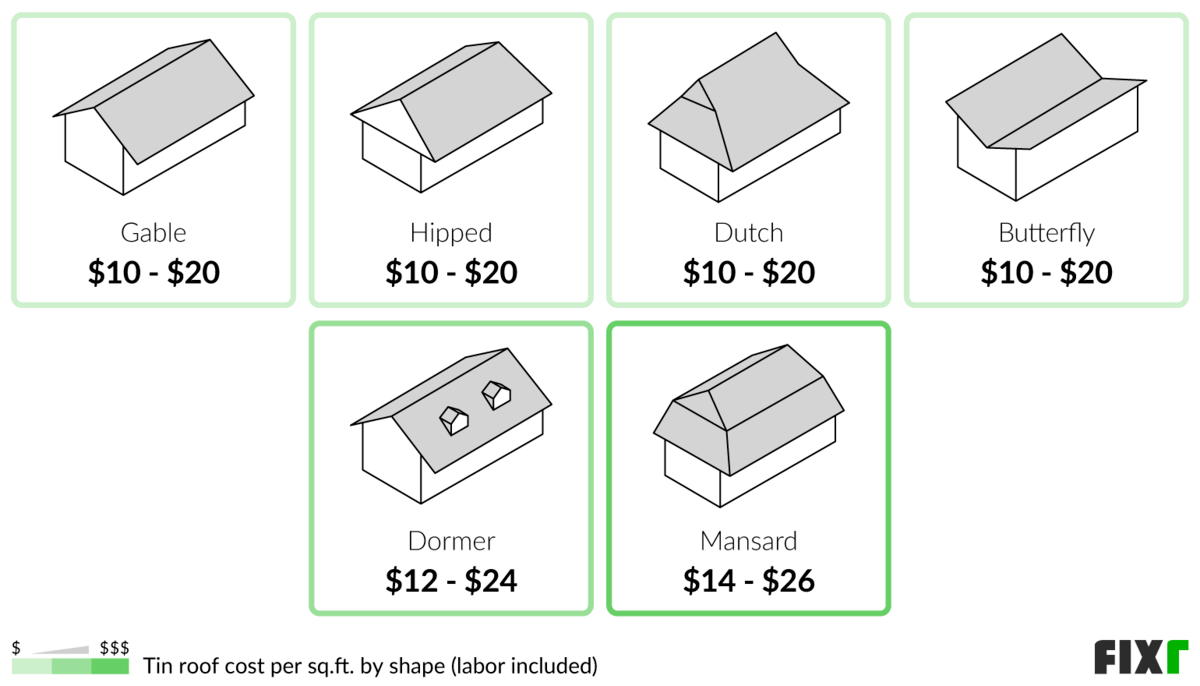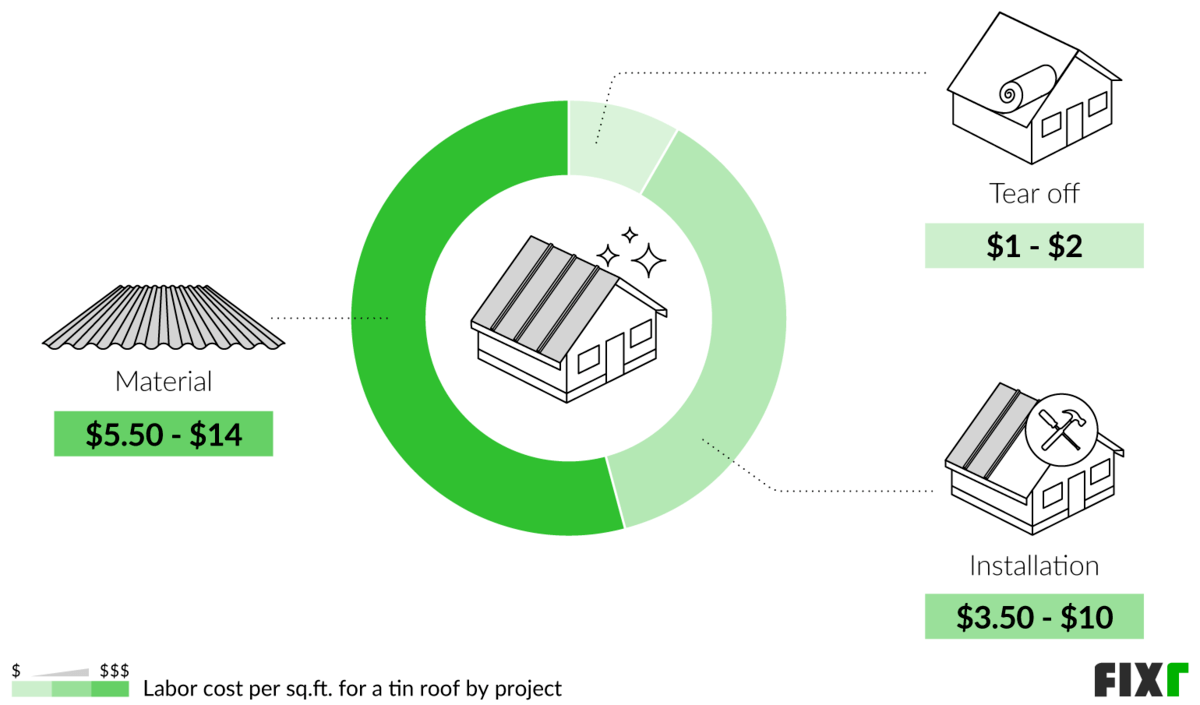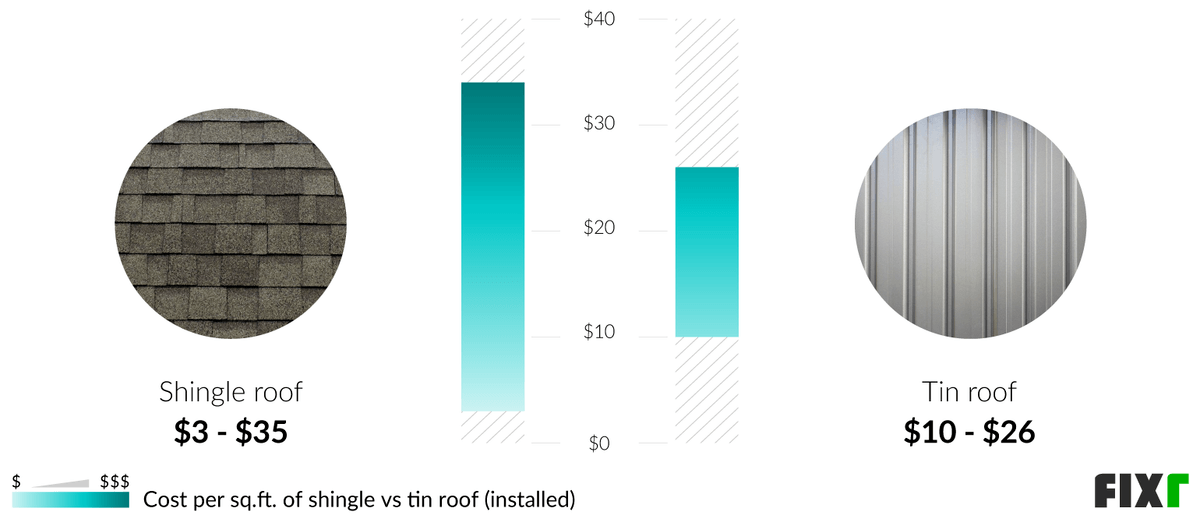How much does it cost to have tin roofing installed?
Get free estimates from roofers near you
Tin Roof Installation Cost Guide
Updated: December 13, 2023

Reviewed by Adam Graham remodeling expert. Written by Fixr.com.
Roofs are one of the most important parts of a home. They protect the home from exterior damage and the elements, which is why homeowners look for durable, long-lasting materials. If you have an older or historic home, you may want to install a tin or terne roof to complement its style. Or, a tin roof can make a beautiful statement if you want an unpainted metal roof with a matte finish. While many metal roofs are called tin roofs, most are made from other materials. True terne roofs are made from rolled steel coated in a tin layer. This guide focuses on the costs of a true tin roof.
The national average cost to install a terne roof is $23,000 to $45,000, with most homeowners spending around $30,000 on a 2,000 sq.ft. standing seam tin roof installed. This project’s low cost is $10,000 for a 1,000 sq.ft. flat-lock tin roof installed. The high cost is $52,000 to install a 2,000 sq.ft. standing seam tin roof with repairs to the roof deck.
Tin Roof Installation Prices
| Tin Roof Cost | |
| National average cost | $30,000 |
| Average range | $23,000-$45,000 |
| Low-end | $10,000 |
| High-end | $52,000 |
Tin Roof Costs per Square Foot
A tin roof ranges from $10 to $26 a sq.ft. installed. Material costs are roughly $5.50 to $14 a sq.ft., while labor costs range from $4.50 to $12 a sq.ft. Costs vary depending on if the roof is flat lock or standing seam and if the material beneath the tin is steel or stainless steel. Stainless steel terne roofs cost more than steel terne roofs, and standing seam terne roofs cost more than flat-lock terne roofs. This creates a wide range of total costs. Like most roofs, tin roofs can be priced by the square foot or square, with one square equaling 100 sq.ft. Below are the total cost ranges for installing tin roofing on roofs of varying sizes.


| Size | Average Cost (Installed) |
| 1,000 sq.ft. | $10,000 - $26,000 |
| 1,200 sq.ft. | $12,000 - $31,200 |
| 1,350 sq.ft. | $13,500 - $35,100 |
| 1,500 sq.ft. | $15,000 - $39,000 |
| 2,000 sq.ft. | $20,000 - $52,000 |
| 2,200 sq.ft. | $22,000 - $57,200 |
| 3,750 sq.ft. | $37,500 - $97,500 |
| 4,500 sq.ft. | $45,000 - $117,000 |
Tin Roof Cost per Square
Like all roofs, tin roofs can be sold and installed by the square. A square is 100 sq.ft. and is the term most often used by roofers when measuring, pricing, and installing a new roof. A new terne roof costs between $1,000 and $2,600 per square, depending on the roof type and style. These costs include the material and installation costs for a tin roof. Because it is a good idea to have extra material, most installers price the roof by the full square, even if your roof has an odd number of square feet. Below are the average costs for installing a new terne roof by the number of squares.


| Number of Squares | Average Cost (Installed) |
| 10 Squares | $10,000 - $26,000 |
| 12 Squares | $12,000 - $31,200 |
| 15 Squares | $15,000 - $39,000 |
| 18 Squares | $18,000 - $46,800 |
| 20 Squares | $20,000 - $52,000 |
| 25 Squares | $25,000 - $65,000 |
| 30 Squares | $30,000 - $78,000 |
| 35 Squares | $35,000 - $91,000 |
Tin Roof Cost by Type
Most terne roofs today are standing seam, meaning the roof is made of panels that meet at vertical angles. The fasteners of these seams are hidden, making the roof watertight and durable. However, older tin roofs may be flat-lock panels or sheets. Large flat sheets of tin are molded to the roof and soldered together. This is uncommon for modern roofing and is mostly used in restoration projects or for historic homes. However, both roof types are available but not as commonly as other roofing materials. Below are the average costs per square foot for each material.


| Type | Cost per Sq.Ft. (Materials Only) | Cost per Sq.ft. (Installed) |
| Flat Lock | $5.50 - $10 | $10 - $22 |
| Standing Seam | $10 - $14 | $14.50 - $26 |
Flat
Flat-lock tin roofs cost $5.50 to $10 a sq.ft. for materials. Installed, these roofs average $10 to $22 a sq.ft. A flat-lock tin roof uses a tin sheet molded to fit your roof. This means a flat-lock roof can be used on curves, domes, and other unusual roofing styles. This roof is very uncommon, and you may have difficulty finding a roofer who knows how to form and solder the sheets to your roof. This roofing is most commonly used in historic home renovations and restorations, so a contractor who works on these homes is the most likely to understand how to install it.
Standing Seam
The cost of a standing seam tin roof is $10 to $14 a sq.ft. for the material. Installed, these roofs cost $14.50 to $26 a sq.ft. This tin roofing is made of panels with tall overlapping edges where the seams “stand” along the roof in even rows. The panels lock at the seams, hiding the fasteners. Standing seam roofs have a contemporary look and are the most common metal roofing style today. Standing seam tin roofs are less common than other metals but have a distinctive matte finish that can be appealing. The pans that make the seams may be found in different widths but not as many as other materials.
Average Cost of a Tin Roof by Type of Alloy
Terne roofs are made by chemically bonding tin to steel. Many types of steel are on the market, and two - standard and stainless - can create a tin roof. Because standard steel corrodes and is more difficult to work with, this terne roof is very difficult to find. Most manufacturers of terne roofing have switched to stainless steel, but a few still make traditional steel terne roofs. Stainless steel has a higher cost base, meaning a terne roof with a stainless steel core has a higher price. Below are the average costs per square foot for both materials.


| Alloy | Cost per Sq.Ft. (Materials Only) | Cost per Sq.Ft. (Installed) |
| Steel | $5.50 - $10 | $10 - $22 |
| Stainless Steel | $7 - $14 | $14.50 - $26 |
Steel Tin Sheet
The cost of steel tin roofing is $5.50 to $10 a sq.ft. These roofs cost between $10 and $22 a sq.ft. installed. Steel tin roofing is not as durable or easy to work with. It is not as common as stainless steel tin roofs. Most steel used in roofing is coated in a material to prevent corrosion and increase durability. While tin prevents corrosion and cracking, it does not do so to the same extent as galvalume or other materials. While this material is still available, most manufacturers have switched to stainless.
Stainless Steel
The cost of stainless steel tin roofing is $7 to $14 a sq.ft. They range between $14.50 and $26 a sq.ft. installed. Stainless steel tin roofing is much more pliant and easier to work with. It is often preferred for flat-lock roofing among installers. It is also easier to form into pans for standing seam roofing, making it preferred by manufacturers. Stainless steel tin resists corrosion better than standard steel. It can be longer-lasting, with more benefits to the homeowner.
Tin Roof Cost by Shape
Because tin roofs can be made in two ways - flat lock and standing seam - terne roofing can be installed on any roof shape or style. This includes gable and hipped, Dutch, and decorative roofs like mansards. Terne roofs are frequently installed on older and historic homes. For this reason, you will see many gable, cross gable, hip, Dutch roofs, and mansards, which are more complex. Roofs with a moderate pitch can use either terne roofing because straight expanses are fairly uncomplicated to cover. Mansards, which have a curve, need a flat-lock roof, but they can use standing seam in other areas. The more complex a roof, the higher its costs. This means a mansard roof is more expensive to install roofing on than a gable or hipped roof. Below are the average costs per square foot to install tin roofing on roofs of various shapes.


| Shape | Average Cost per Sq.Ft. (Installed) |
| Gable | $10 - $20 |
| Hipped | $10 - $20 |
| Dutch | $10 - $20 |
| Butterfly | $10 - $20 |
| Dormer | $12 - $24 |
| Mansard | $14 - $26 |
Tin Roof Replacement Labor Cost
Tin roofs are mostly found on older homes and historic homes that are being restored. This means when you have a new tin roof installed, you are likely removing an existing roof or roofing over your existing roof with tin. This means the installation costs typically include removing the older roof. Labor costs for installing a terne roof are $4.50 to $12 a sq.ft. or $450 to $1,200 per square, depending on the material and tin roof type. Stainless steel is easier to work with and may have lower costs than steel. Standing seam roofs are generally more labor-intensive with higher costs, but installing a flat-lock roof on a curve can also have higher costs.
Flat-lock roofs must be installed directly on the roof deck in tin roof installations. Standing seam roofs can install over an existing material if the roof is in good shape. However, most people prefer to remove the older roofing so that the deck can be inspected and repaired if necessary. Below are the average costs per square foot for installation, material, and tearing-off the roof.


| Project Area | Average Cost per Sq.Ft. |
| Tear-Off (Optional) | $1 - $2 |
| Installation | $3.50 - $10 |
| Material | $5.50 - $14 |
Tin Roof Insulation Cost
Terne roofs do not come with insulation like some aluminum roofs. However, you can insulate the underside of your roof deck. Doing this prevents thermal transfer from the roof into your attic or from a superheated attic to the roof. You can use any attic insulation from fiberglass batts to spray foam in this area, but foam insulation - spray foam or rigid foam board - is the most recommended. Insulating this area costs between $2,400 to $8,000.
Pros and Cons
Tin and metal roofs last much longer than other popular roofing materials. 40 years is considered the minimum life you get from a metal roof, and some old tin roofs are more than 100 years old. Because of this longevity, adding a metal roof can also increase your home’s value. Tin roofs can also enhance a historic home and are frequently used when restoring older homes that may have originally had a tin roof.
However, there are a few drawbacks. Tin roofs are less common than other roofing materials in many areas, and it can be more difficult to find a contractor who is experienced in working with them. You may also have difficulty finding a true terne roof material because the term tin roof has become synonymous with metal roofing over the years. They may also dent, so if you live in an area that sees hail, a tin roof may not be the best option.
Maintenance
Tin roofs have little maintenance. They do not leak or require sealants or other topical additives when properly installed. They resist moss and algae growth and can be cleaned with a low-pressure wash, costing $0.30 to $0.70 a sq.ft. While tin roofs resist denting, cracking, and corrosion, these things can still occur. Have your roof inspected periodically as part of your maintenance for $100 to $600 to ensure it remains in good condition. You can also apply a sealant if you are not using stainless steel. This can further increase the corrosion resistance but is not necessary for all terne roofs. Speak to your installer about what may be necessary for your roof.

Cost of a Tin Roof vs Shingle
You have many options for installing new roofing on your home. While tin roofs are uncommon and used primarily on historic and older homes, shingles are a common material installed on most homes. There are several types of shingles. These include low-cost asphalt shingles, architectural shingles, and shingles made from metals like copper. This means shingles can have a wide range of costs, appearances, and durability.
Tin roofs are less common and have fewer options. However, they are low maintenance and last more than 100 years when properly installed. Below are the costs per square foot for shingle and tin roofs installed.


| Roofing Type | Cost per Sq.Ft. (Installed) |
| Shingle | $3 - $35 |
| Tin | $10 - $26 |
Enhancement and Improvement Costs
Sealing a Tin Roof
Some steel terne roofs may need to be sealed but not always. If you live in an area with salt, such as along coastal regions, sealing can prevent corrosion. This costs $1 to $2 per sq.ft. Sealing is usually clear and does not change the tin’s color. It must be reapplied every 5 years.
Gutters
Installing gutters costs $3 to $50 per linear foot installed, depending on the material. They direct water from your home’s foundation, otherwise causing damage and soil erosion. Gutters are typically installed where rainwater needs to be directed from your foundation, so the exact number of gutters you need depends on your home and area.
Roof Penetration Flashing
Flashing is a necessary part of every roof installation. It helps line valleys and seals roof penetrations. This includes stack lines, chimneys, and skylights. Flashing is added to every roof installation, but if you have several penetrations - multiple chimneys or skylights - it could increase costs by $50 to $100 per penetration. Speak to your installer for more information.
Tin Roof Painting
While uncommon, you can paint your tin roof. The paint should use a primer for metal and must be applied to a clean, dry roof. Painting the roof costs $1.50 to $4 a sq.ft. Painting the roof increases your maintenance because the paint will flake and need to be removed and reapplied. Some metal paints may also fade and become chalky.
Additional Considerations and Costs
- Efficiency. Metal roofs can often improve a home’s energy efficiency by 10% to 15% or more. This can be of particular benefit to households located in very hot or cold climates.
- Reroofing. New metal roofs may be less expensive to install than a replacement metal roof if you roof over the existing roof. Removing the old roof increases costs.
- Pitch. Your roof’s pitch or slope impacts the installation costs and materials. The higher the pitch, the more expensive the installation, and the more limited the options.
- Cool roofing. While metal roofs can get hot in the sun, you can paint your roof a light reflective color that makes it a cool roof.
- Flame retardance. Metal roofs are flame-retardant and protect your home. Contrary to many myths, they do not attract lightning nor increase the chances of a lightning strike.
- Permits. Some areas require permits for a new roof, while others do not. Check with your local town or City Hall to determine if you need a permit.
- State. Tin roofs are very uncommon, and you may have trouble finding them where you live. The roof and labor costs vary by location, with midwest and southern states having lower costs than the West Coast or New England.
- Patina. Older terne roofs containing lead develop a patina. However, newer terne roofs, which do not contain lead, do not patina or change color.
- Rarity. Terne roofs are uncommon. For this reason, you may struggle to find a contractor who knows how to install them properly.
- Property age. Terne roofs are most commonly installed on older and historic homes. While they can be put on newer homes, this is relatively uncommon due to the rarity of the material and contractors who work with it.
FAQs
- Are tin roofs cheaper than shingles?
Generally, no. There are many types of shingles, and some shingles can be made of materials like copper or slate, which may be more expensive than tin. However, many shingles are less expensive, including asphalt.
- How to put a tin roof on a mobile home?
Tin roofs can be installed on mobile homes to improve energy efficiency and provide a long-lasting way to protect the mobile home.
- Can you paint a tin roof?
You can paint a tin roof, but it is not necessary. You need a primer and paint designed for metal, and you should keep in mind that it will likely fade with time.
- Where to buy tin roofing?
Tin roofs are relatively rare. Find an installer who works with the material, and they can source and install it for you.
- How long does a tin roof last?
Tin roofs have a very long lifespan of 40 to 70 years, but if they are maintained properly, their lifespan can be up to or beyond 100 years.